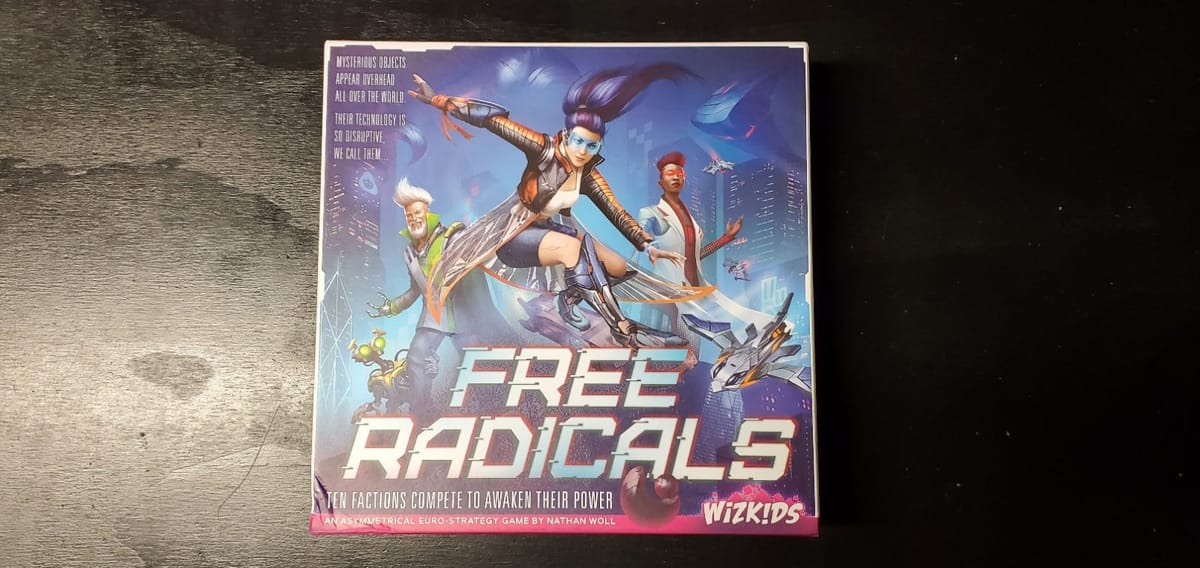
Outside of Gùgōng and games made by Vita Lacerda, I can’t recall the last time I’ve had this much fun with a Euro. I also can’t recall the last time I had players eagerly, immediately, and unanimously request that we reset the game and play again right after we had just finished playing our second game in a row – and that happened multiple times with different groups of players.
Overview
Free Radicals is a radically asymmetrical Euro by Wizkids, and the goal is to have the most victory points (VP) after 12 turns. The game plays 2-5 players and has 10 different factions divided into 5 different color groups, and has a ton of replayability. It has 32 different faction combinations at 5 players alone, and that’s not counting the fact that players will probably want to play different faction combinations as different factions. (For just the 5 player game, you could have 160 permutations of players and faction setups if you have 5 players who really want to try playing each faction in each combination of factions headed by each possible player.)
Thematically, Free Radicals is about 10 factions of people trying to decipher and utilize the knowledge and technology stemming from giant, enigmatic, alien artifacts that just showed up one day in the sky. While some of my players have thought Free Radicals had a cyberpunk theme, the game is very much about humanity in a post-scarcity environment (due to alien-derived “free radical” technologies) that are investigating alien artifacts. While Free Radicals is very brightly and loudly colored, it has no dystopian elements I can find. It’s safely post-cyberpunk.
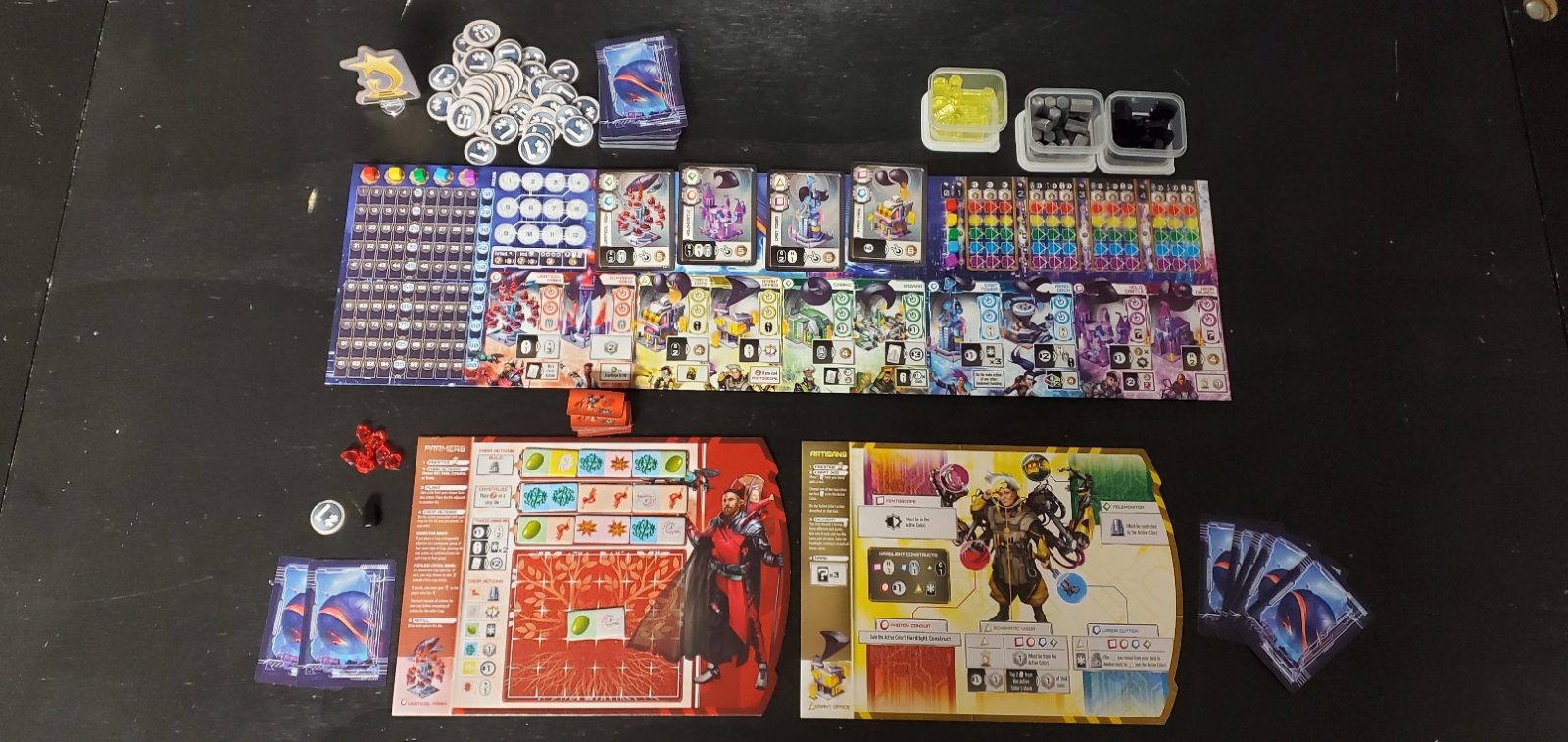
Now is probably a good time to talk a bit about how Free Radicals works. However, with 10 radically asymmetrical factions, there’s a bit too much to dive into too deeply mechanically, so everything here is going to be fairly high level. Also, while I’ve played as every faction at least once at a player count, I have not played as every faction at every player count let alone the multiple times at every player count one would really need to do in order to really dig in and do a critical evaluation of the mechanics. To set expectations, I rarely won but, I didn’t do particularly poorly either.
Common Elements

While each individual player faction has different player boards and operates under different rules, there are some communal elements. Unfortunately, the common elements tend to be very visually loud and busy, and sometimes cluttered. This can lead to a number of problems.
In addition to housing the round and score trackers, the main board is home to the Data card display, Knowledge track, and Buildings. When players get the opportunity to gain a Data card via the [*] symbol, they can select any of the 4 Data cards in the market, or draw a card off the top of the Data card deck. Conversely, a [?] symbol just grants the player a random card off the top of the deck. Initially confusing or misinterpreting [*] and [?] was huge problem for most people I played with, and the difference between having to top deck a random card and picking between 4 known cards with the option to top deck a random card if you don’t like your known options can have significant game effects, both in what building you can Awaken and for certain faction-specific mechanics.

While different factions may have different uses for Data cards, the common use for them is to Awaken Buildings. This was something many players initially struggled to digest as well. To activate a Building, a player must take an Awaken Building action, have a Data card matching the Building they want to Awaken that has one of their faction color/symbols in the upper left hand corner, be able to pay the cost on the bottom left of the card, and then gain the VP listed in the bottom right of the card. This may sound simple enough. However, during play a lot of people had trouble initially connecting the idea that they needed to have not only the card of the building they wanted to activate, but also for that card to have a symbol/color that matched their faction symbol/color.
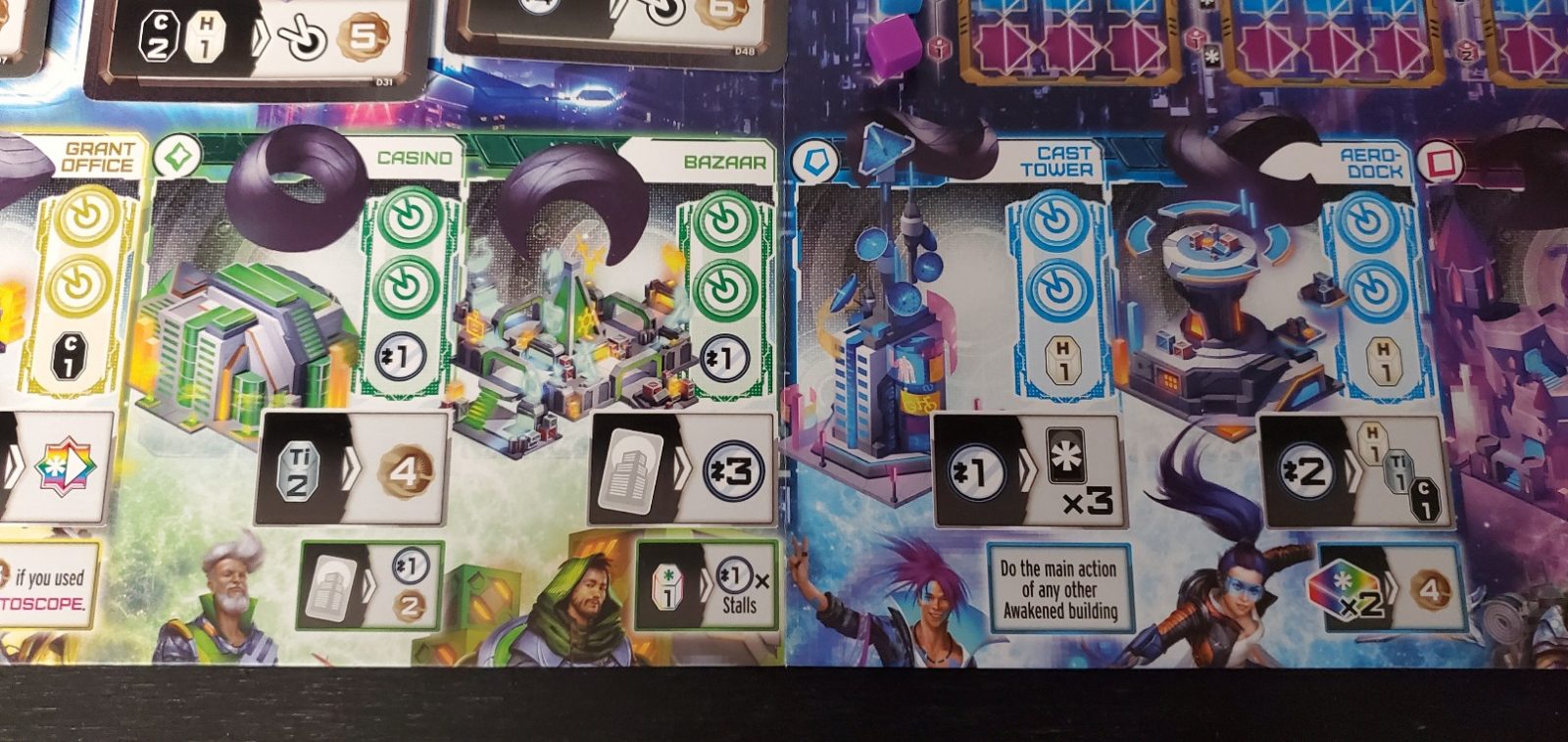
Another source of confusion revolved around building actions. Once Awakened at least once (by anyone), Buildings can be visited using the visit Awakened Building action. While each Building has different functions, each faction has a Building at which they can instead take a special action. Players can take the standard action OR the faction specific action IF it matches their faction. For example, the Cast Tower has the Entertainers (Blue) special action. When visiting the Cast Tower, the Entertainer player may choose to (main action) pay 1 credit to draw 3 Data cards OR (faction action) do the main action of any other Awakened Building. Many players interpreted the board as allowing them to take both the standard and their faction action.
Buildings had some balance issues as well: not all buildings were equally rewarding to build. When a player visits a building; the player, or players, who Awakened the building for the overall first and second time gain a favor from the visitor and the listed item. If a single player Awakened the building for both the overall first and second times, they gain 2 favor and 2 of the listed item. As not all buildings are equally useful at all points in the game, certain buildings will likely be visited more early in the game, and are more valuable for their passive bonuses. Notably, Vertical Farm (which can convert any 1 resource into any 3 resources) and the Bazaar (which allows you to discard any Data card for 1 credit) combined with the Cast Tower were very popular in most of my games, and resulted in a lot of passive favor and item income.
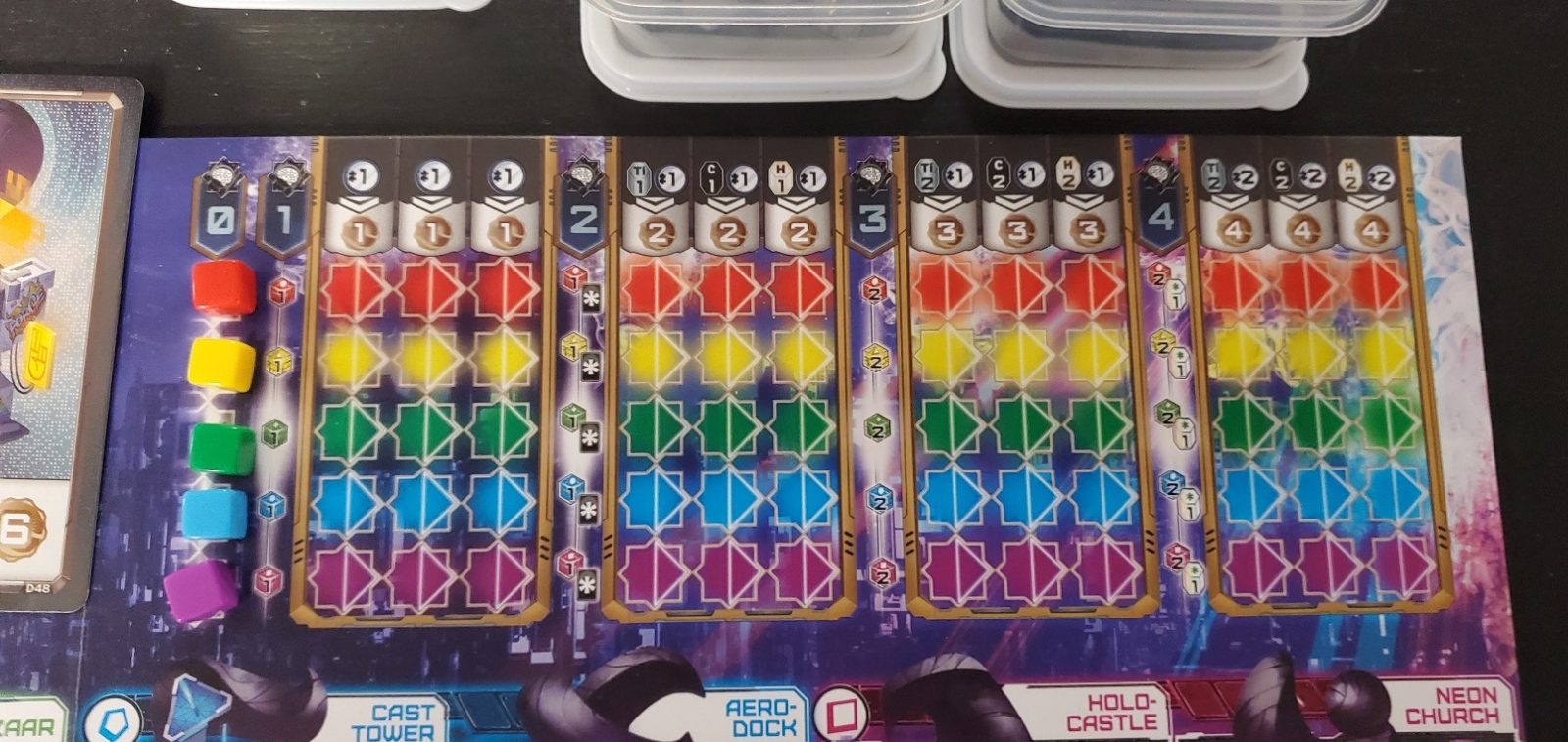
The Knowledge track was mostly neglected in a lot of games, save by maybe one or two players each game who would invest deeply. Whichever player is the farthest along on the Knowledge track at the end of the game gains 7 VP with second place gaining 3 VP. However, players tended to determine early on if they were going to be involved in the Knowledge track or skip it – and, if two people had already started moving up on the track, all the other players tended to just ignore the track completely. While it was possible to advance any player up the Knowledge track for VP and any player other than themselves for various rewards (most notably favor); no one tended to advance anyone else outside of the last few rounds of the game and even then it was rare.
One surprisingly major shared mechanic was end game scoring of favor. At the end of the game, the player with the most favor of other factions gains 7 VP, and the player with the second most favor of other factions gains 3 VP. Additionally, for each set of 4 different colored favor from the other factions, the player gains 2 VP. Note: If you are playing with less than 5 players, this does mean that favor has to be gained from non-player/inactive factions to complete color sets. The matched set bonus could actually prove to be pretty major, causing maybe a 10 or even 20 VP swing for a player who had been carefully gathering both a lot of favor and managed to keep it fairly well distributed across factions.
Lastly, there is a Prestige token. Whenever any player takes it from another player or holds it at the beginning of their turn, the player gains 1 VP. If the player already holds the Prestige token and performs an action to take it, they gain 2 VP instead, and this is a very powerful scoring mechanism. A number of factions have ways to repeatedly grab the Prestige token during their turns, and they can potentially generate maybe 10 VPor more in a single turn by grabbing the Prestige token they already hold over and over again.
Factions
This is the party trick – and it’s generally a good one. It’s also what I think will make or break this game for you. If the notion of radically asymmetrical factions doesn’t resonate with you and your players, you probably will be happier passing on this game. There are games out there centered around single mechanics that do everything any individual faction here does but better – but those other games are also often just centered around that one mechanic.
In Free Radicals, there are 10 different asymmetrical factions that the 2-5 players can play, two for each color, with only 1 faction of each color being allowed to play at a time, leading to 32 faction combinations at 5 players (and 80 faction combinations at 2 players). If every player in a 5 player group wants to play every faction in every possible faction combination in 5 player games just once, you could potentially play this game 160 times. The same goes for 2 players: both players playing every faction in each 2-faction combination would be 160 game setup permutations. Ignoring the 3 and 4 player counts, that’s already 320 game setup permutations. If you want to experience everything this game offers, there’s a lot of play here. I’ve personally put in a number of plays in the low dozens, and I’ve barely scratched the surface of everything that’s here.
With radically asymmetrical factions, Free Radicals could easily turn into a bear to teach. As it is, I practically lost my voice every time I taught this to a new group of players. However, Free Radicals does a pretty good job here helping most players with playing their faction. Each faction has a 1 page (front and back) rules sheet going over all their faction specific setup, rules, components, and abilities in detail, and each faction’s player board has a step-by-step breakdown of how their turn works. While this can be overwhelming for some players, I’ve found a heavy correlation between players who get excited when handed a sheet of new rules at the start of each game with the expectation that they will largely brief and teach themselves their factions rules and people who really enjoy this game.
If that last sentence describes you, you know who you are. Assuming you have at least one similarly minded friend, stop wasting your time reading this review: go buy and play this game. You already know you are going to play it at least 5 times, if not 10 times, minimum – and you know that’s already more mileage out of this game than you get out of most other games you’d buy instead. Go on – git!
Farmers (Red)
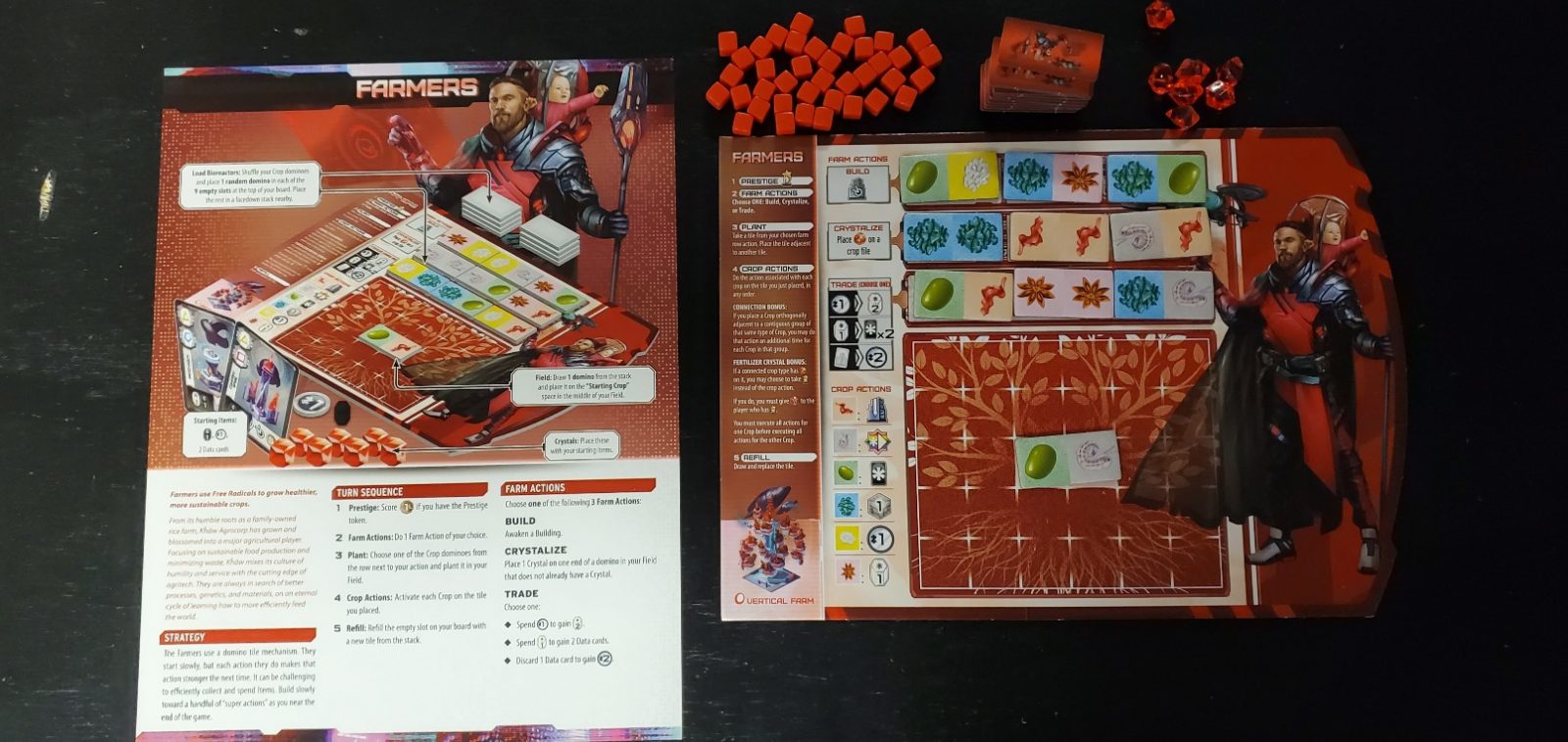
The Farmers are playing a domino-style game. Every turn, they’ll take 1 of 3 static Farm actions, and then they’ll place 1 Crop tile from the 3 in the row corresponding to their Farm action into their field adjacent to another already laid Crop tile. If the Crop symbols of the Crop tile just place create matches orthogonally, the Farmer can take a number of Crop actions equal to all Crops that connect together to the match, given they are the same Crop type as the match.
More than any other faction, I received the feedback that the Farmers were overpowered. The only two blowouts (100+ VP) I’ve seen have both been performed by players playing the Farmer faction. However, I think that might have been more due to the combination of the quality of the players playing the faction, the player count, and the focus of the players in the game. Out of 5 games where the Farmers were played, 2 were blow outs (100+ VP win), 2 were busts (last place), and 1 had the farmer end up in the middle.
Given how the Farmer can chain Crop actions, they can pull off some amazing plays. However, it does take some skill to plan ahead, and it can require knowing where other players will go. The 2 fairly seasoned gamers chaining the visit Building action was extremely powerful in the two 5 player games where everyone rushed to Awaken every Building ASAP. Conversely, the more casual gamers playing Farmers didn’t have that same level of explosive growth via that Crop action in a 4 player game where players weren’t focused on Awakening Buildings nor in 2 player games where there were just less or more slowly Awakened Buildings due to lower player count.
Executives (Red)

The Executives play a mancala-style game which… I’m not even going to try to explain in this limited space. Each space potentially allows you to do different things depending on what assets you have in the space you end up in. Out of all the factions, I think the Executives probably take the most planning/forethought of any faction and are probably the second most mentally demanding/hardest to learn of the factions. Not a faction I’d generally give to someone who described themselves as a casual or light gamer, unless maybe they are really into mancala.
Artisans (Yellow)
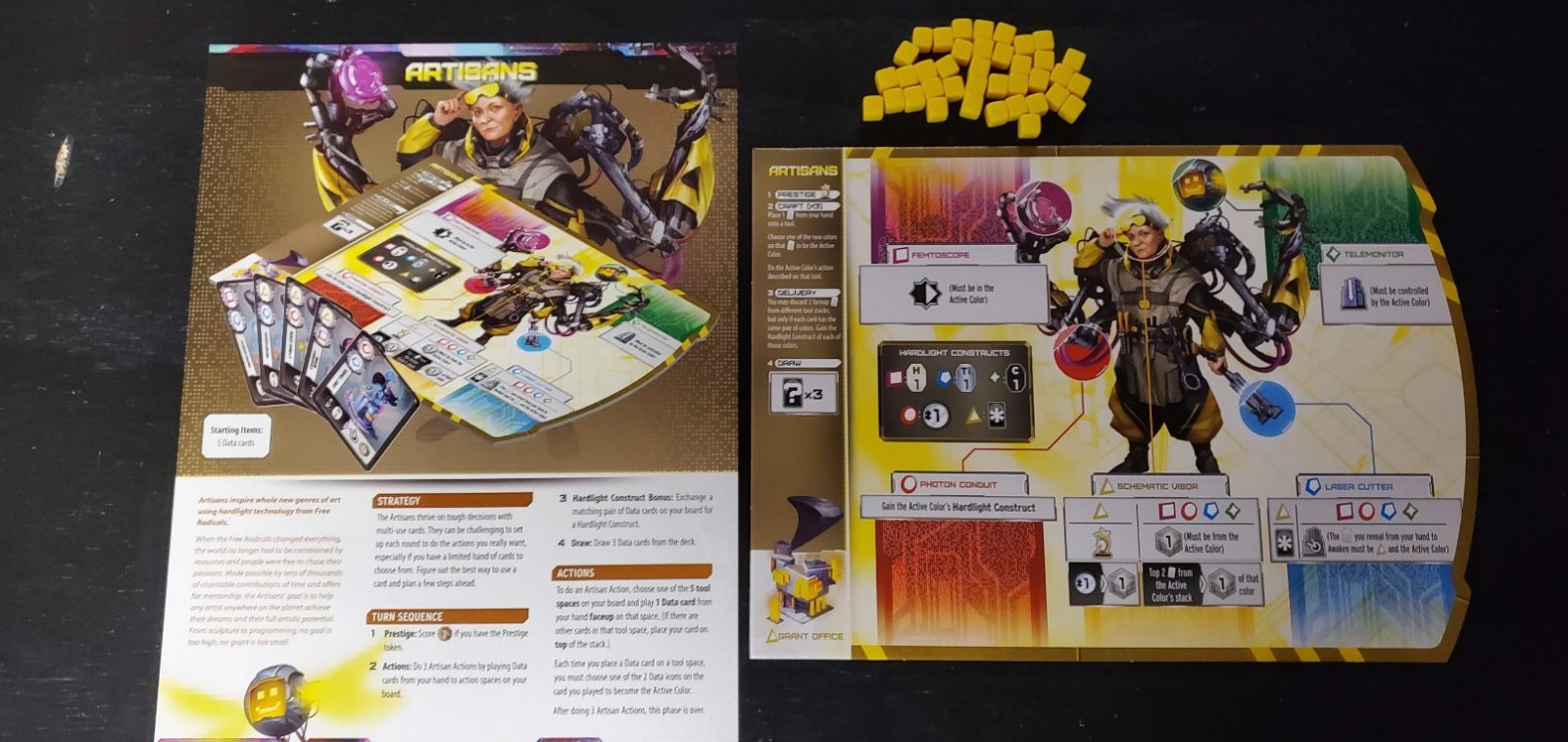
This is probably the hardest, or at least most tiring, faction to play. The Artisans are all about hand management and set collection. Every turn, you’ll place 3 Data cards from your hand (one at a time) onto 1 or more of the 5 board spots and choose which one of the colors/symbols is the Active Color. What happens is based both on where you placed the card and what color/symbol on the card you stated was active. After playing 3 cards, if you have 2 cards that have both colors/symbols match, you can remove them from your board and get a bonus based on what both colors/symbols are.
When I played them, I did ok but I didn’t really have any fun with them at all. The only other player who played the Artisans struggled hard and was not really competitive. I’d be cautious of giving them to, really, any player unless they really got excited when they took a look at the Artisan side of the yellow board.
Underground (Yellow)
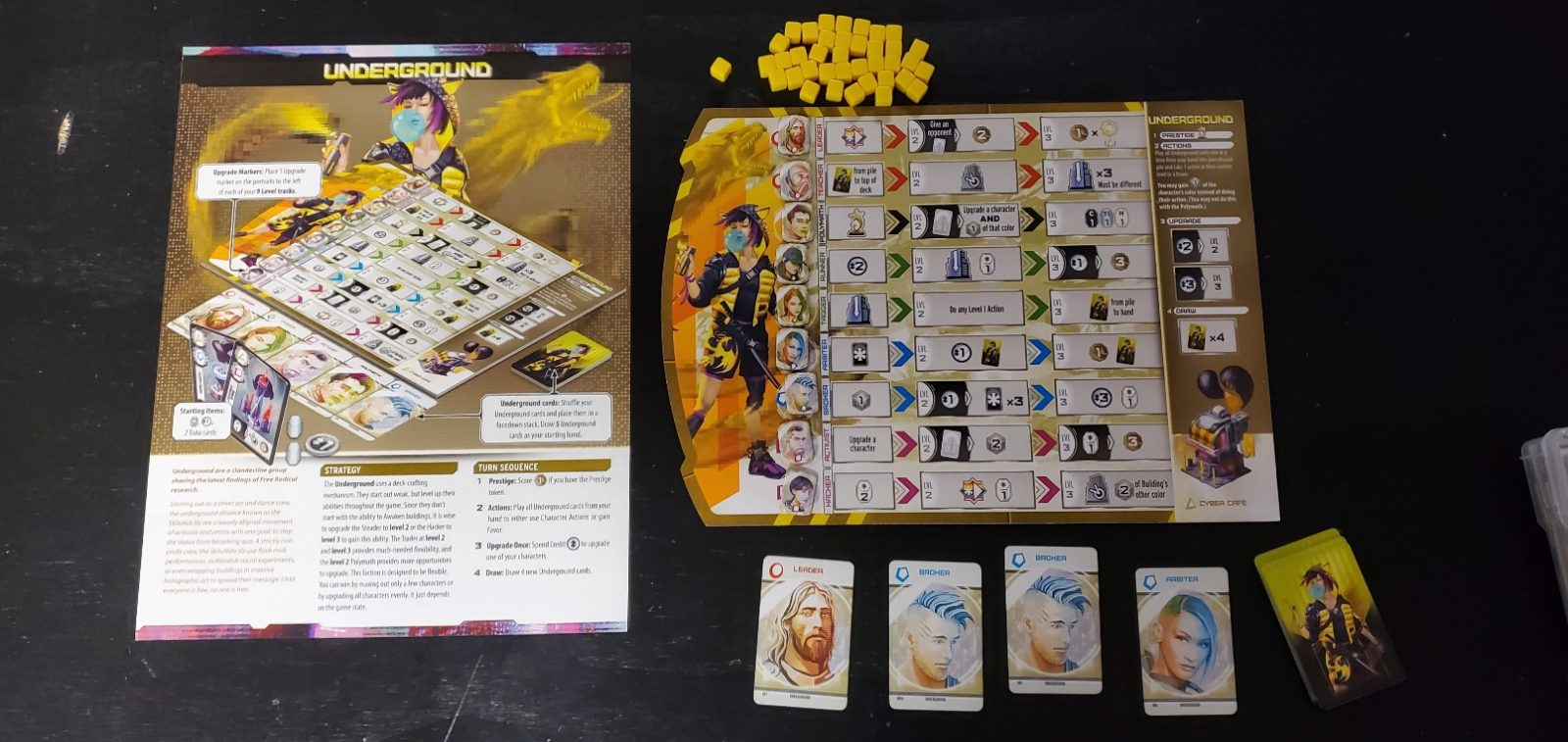
The manual describes this faction as “deck building”. It works as a description, but I don’t think it’s really accurate. You get a deck of cards that contains two copies of 9 characters. At game setup, you’ll draw 5 cards. Thereafter, you’ll draw 4 cards at the end of every turn. During your turn, you’ll resolve the actions available to you based on the characters you flipped over. You can upgrade the characters (tracked on your main board) to give you access to more advanced actions, which is kinda sorta where the deck building analogy comes from.
A lot of people chose to play the Underground: more people were interested in playing them than any other faction. No one had a bad time with them and most people playing them were pretty enthusiastic. The Underground tended to start off very slow score-wise. However, they tended to make very big gains late game and were always competitive.
Hoteliers (Green)
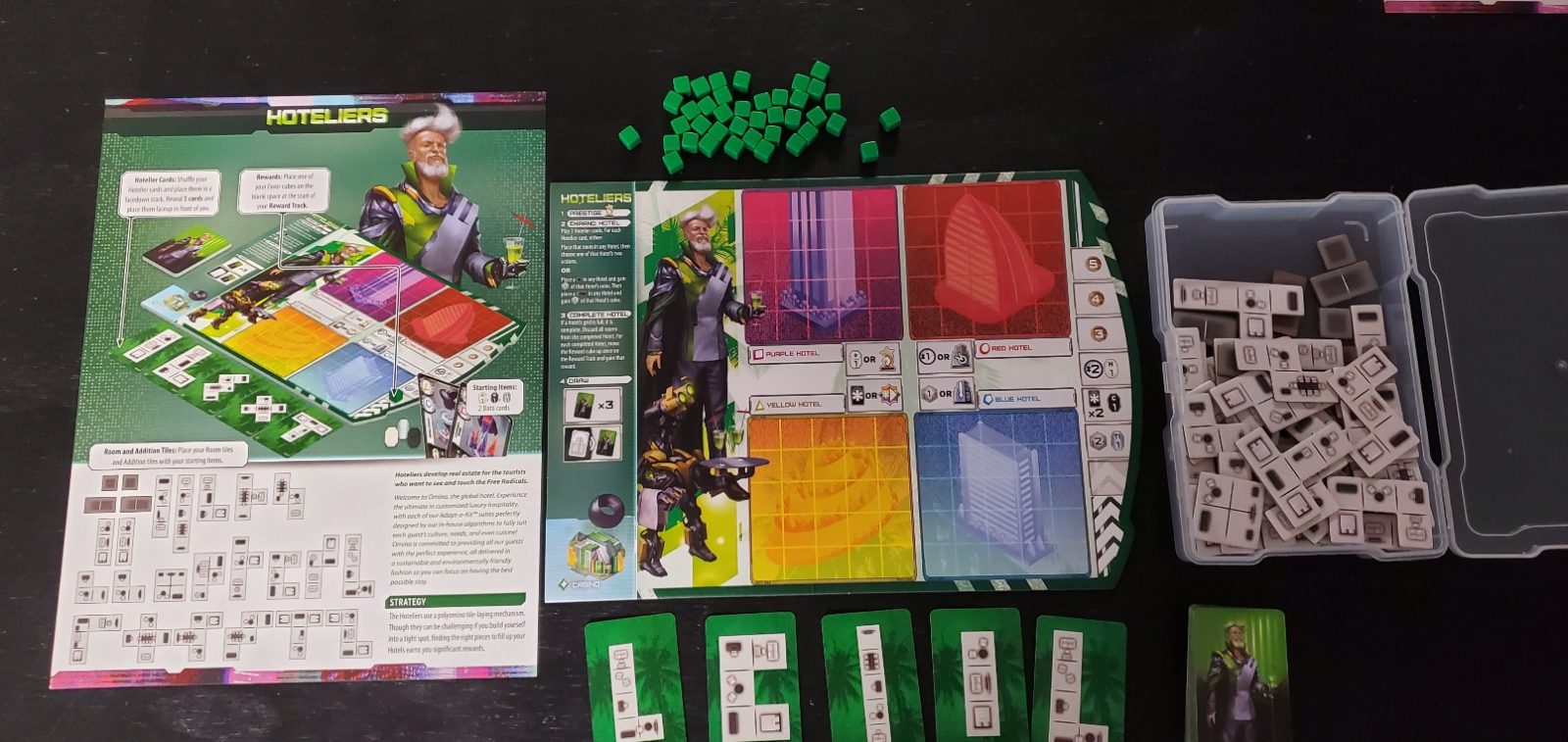
Every turn, the Hoteliers will be placing 3 polyominoes from a pool of randomly drawn ones (proxied in pool via card). The polyominoes can be placed in any of the 4 differently colored Hotels, and each placement will give a different reward (as marked on the player board). When a Hotel is filled, it is cleared and an ever increasing set of rewards are given out. There is a way to place single tiles, so you don’t have to worry about getting stuck.
This is the other faction I heard complaints about. All 3 players other than myself who played them came in last place in each of their games, leading those players to feel the Hoteliers weren’t properly balanced. I didn’t have the same experience when playing them though. I’m not sure if I got lucky, or if it was a skill/preference mismatch for the other players.
Merchants (Green)
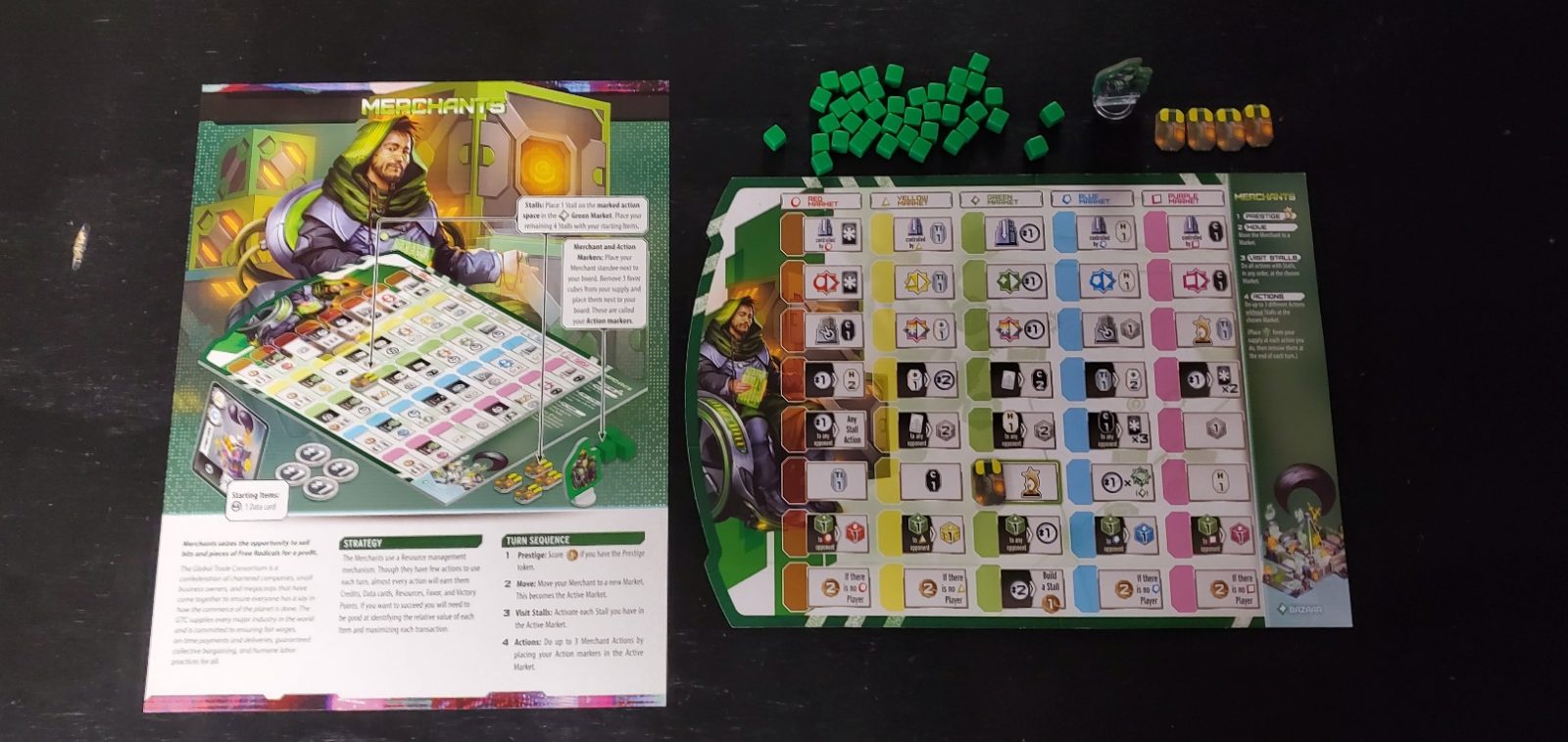
The Merchants have super-simple gameplay and were not a particularly popular choice in games I played. You move the Merchant marker to 1 of the 5 columns you aren’t currently in, take an action for any of your stalls built in that column, and then take any 3 other actions in that column. The Green column has an action that allows you to build a stall anywhere you don’t already have a stall, and you can have a maximum of 5 stalls. For the most part, the Merchants just exchange 1 resource for slightly more of another resource.
Couriers (Blue)

Surprisingly, the Couriers play a pick up and deliver game. You pick up your 3 drones and lay them down in a series of adjacent spaces starting with a space adjacent to where you picked them up from. You resolve the top action of each space you place a drone in the order you placed them. You then pick up 1 of your drones at the end of your train, then the middle drone, and then place the removed drones on top of the remaining drone. For each location starting where you picked up the first drone; you then gain 1 credit, buy what’s available for sale at that location, or make a delivery/fulfill a contract. Completing contracts gains you both VP and certain bonus actions if you have a drone in a corresponding space on future turns.
The Couriers were a fairly popular faction to play as. Everyone who played them seemed to enjoy them. I don’t recall the Couriers ever winning a game, but they were competitive.
Entertainers (Blue)

The Entertainers are very random, but (surprisingly) were still competitive. As the Entertainer, you get dealt 5 cards at setup up and at the end of each turn from a 12 card deck. Each card has 3 possible actions available on the card, with a fourth possible action being playing 2 cards to allow you to Awaken a building. You have to play 4 of the 5 cards and place the remaining card on 1 of 2 stages. Each stage has 3 spaces. When a stage is full, the cards are removed from the stage and, if all 3 cards are the same color, you get a bonus. All cards not on stage are shuffled together before dealing out your new hand at the end of your turn. No one seemed to have a bad time with them.
Adventurers (Purple)
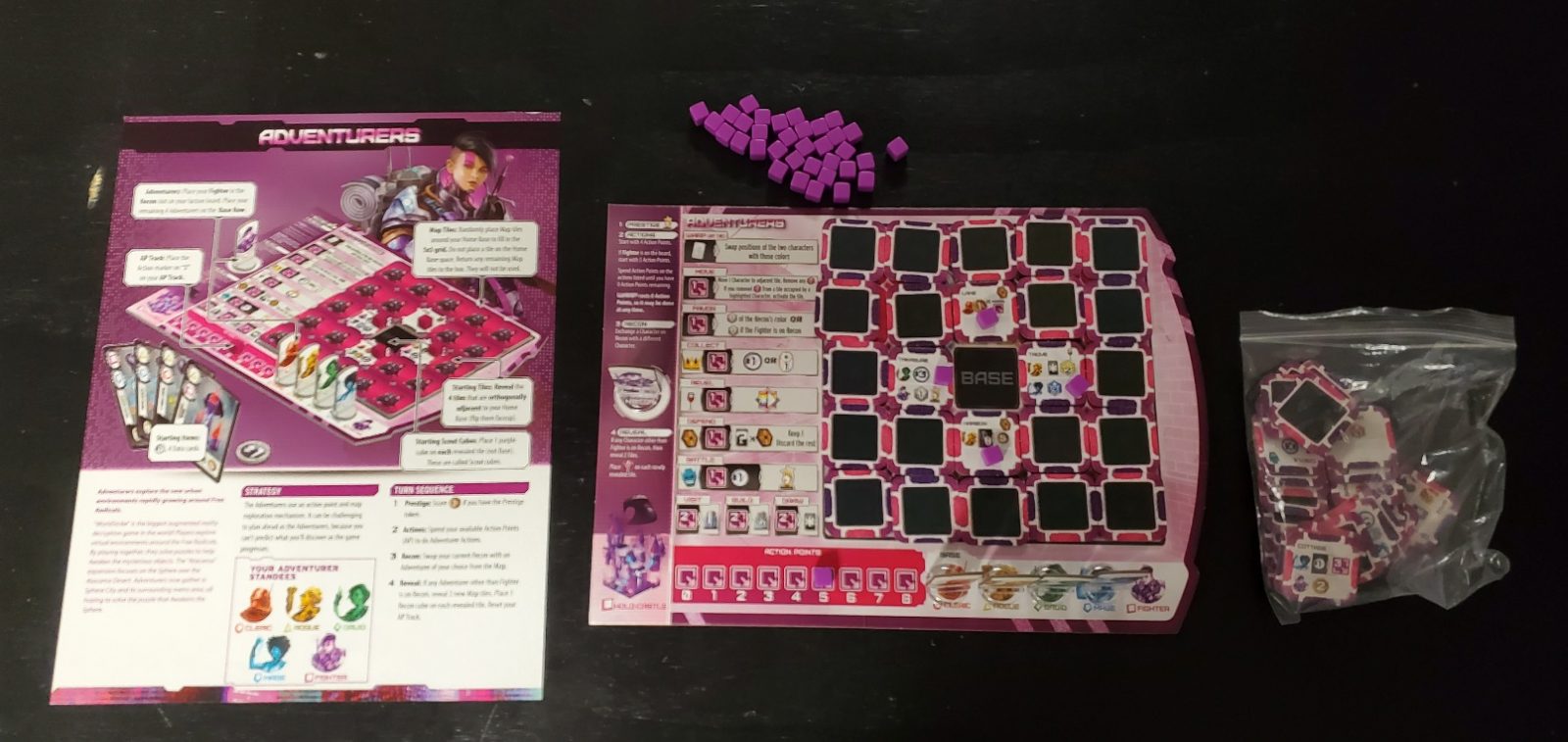
The Adventurer player has a lot going on – too much to really cover well here – but it’s not particularly hard or complex. The Adventure has 5 Adventurers they can use to explore face-down tiles on their board and take various actions. Each action costs a variable amount of Action Points, of which the player only gets a certain amount to spend each turn. There are a lot of tiles used to build each game’s Adventurer board – several times what can actually be used in any game. While this does mean that an Adventurer player could end up with a board that is amazing or a complete bust, I haven’t seen that happen in practice yet. The Adventurers were yet another popular choice to play, and one with which everyone who played it seemed to have a lot of fun. They were also very competitive.
Paladins (Purple)

The Paladins are arguably the simplest group to play. Every odd turn, you place your 5 workers on a spot on your board and take the action listed next to it. Every even turn, you recall your workers and upgrade a worker (if able). When upgraded workers are recalled, you take the action listed next to the space they were recalled from.
Paladins are pretty dead simple to play. They were also very popular, and everyone who played them seemed to enjoy playing them. Despite having effectively fewer turns than other players (particularly early on), they were very competitive.
Art Design & Usability
My biggest criticism of the game probably lies with the art direction and component design. While visually striking, the art is very bright, loud, and busy. The most common issue players had was trying to digest and parse everything they were seeing on the boards and even on the cards. (The player rule sheets were a notable exception.)
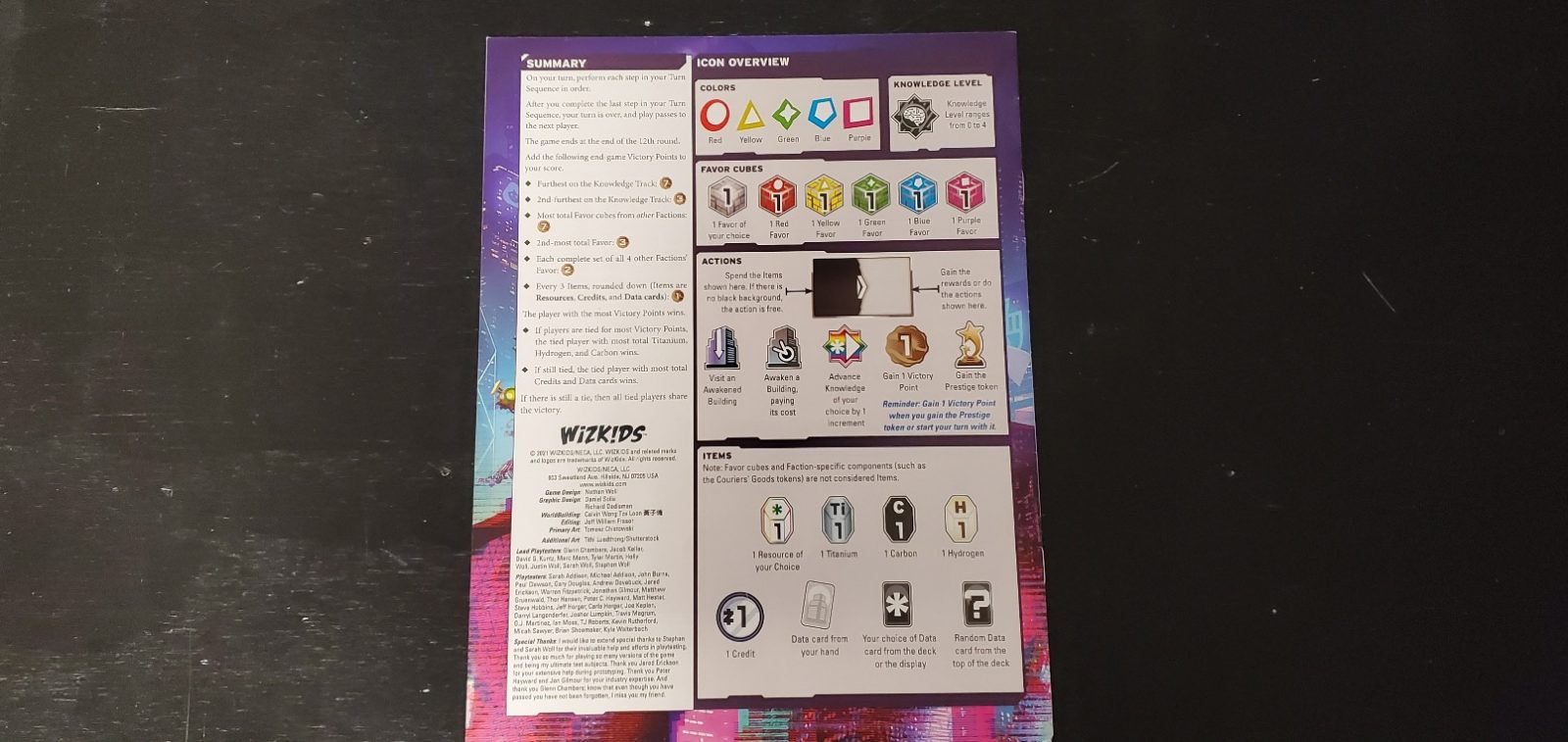
My second biggest criticism is probably that there are no individual player aids for the symbology. The only reference location is the back of the manual. 5 playing card-sized reference aids with the meanings of symbols laid out would have been very helpful. As it is, I tended to prop up the rulebook such that everyone could see the back while playing.
Shout out to Nathan Woll (the designer)
Quite frankly, with 10 radically different factions with completely different mechanics, Free Radicals is an impressive feat of design by Nathan Woll even before looking at balance. While not every combination of factions is perfectly balanced at every player count, the game is way more balanced than I was expecting. Even though I had some outliers, many games ended with players within maybe 20 points of one another. I wouldn’t describe the scoring as tight by any means (given the score track goes up to 100 points). However, I am a huge fan of asymmetrical games and I recognize that Woll had a far harder challenge than what faces many radically asymmetrical game designers. Many radically asymmetrical games are direct competitions that have high levels of player interaction and can rely on games to “self balance” by players ganging up on other players who might be doing well. With Free Radicals being a more conventional Euro game, where a lot of players actions happen on their own boards and there is limited player interaction; the challenge facing Woll – of making 10 asymmetric factions come close to one another in a victory point race – was huge, and I think he did a far better than what I would have expected. It’s not perfect by any means. However, it is pretty damn impressive, and I look forward to seeing what Woll will do next.
Free Radicals
Excellent
Free Radicals is one of vanishingly few radically asymmetrical Euros, and is an impressive bit of game design. While it’s not as good at any individual mechanic as Euros dedicated to a particular mechanic; it manages to be basically 10 Euros in 1 game. With the right group of players, this is an awesome party trick that can go a surprisingly long distance.
Pros
- Every time you play a new faction, it’s like learning a new game.
- There are a ridiculous number of potential faction-player-player count combinations to experience.
- After your first play, your play time can easily be an hour or just over.
- It is very easy to plan out your next turn while waiting for it to come.
Cons
- Every time you play a new faction, it’s like learning a new game.
- There are other games that do each faction’s mechanic better.
- With so many potential faction and player count combinations, some combinations are bound to be less balanced than others.
- If you have even one AP prone player, you can easily double the play time.
- The art and design is very loud and busy.
